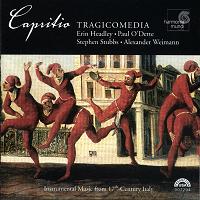
Capritio
Instrumental music
from the 17th Century -
reviewed by JENNIFER PAULL'... ensemble playing at its best. O'Dette is an outstanding performer.'
|

|
'Art is a house that tries to be haunted.'
-- Emily Dickinson, poet (1830-1886)
This is a very interesting CD. Nobody should even contemplate going to
Italy without it. Walking around Rome with this music as a companion could
only make the architecture -- to which the term 'Capritio' equally applies
-- stand out in more, haunting relief, and bring its ghosts of many
centuries past, back to life.
Upon a list of ingredients that I find more than positive, there are
those, which I do not. The CD booklet is well presented in three languages,
but there is nothing written about the ensemble. One can but surmise that
these four really excellent musicians were combined for this recording.
The necessity to 'give the lead' or enter piano with
an up-bow or up-beat, translates into one disagreeable irritation: the audible
sniff.
As a wind player, I know full well that one can never eradicate all breaths
from a recording; one simply has to remain alive to be able to play the
last track! But here, there are no wind instruments. This does underline
that the performance is little edited, which is a good thing, yet somehow,
there are just too many sniffs for comfort. Of course, close miking is necessary
for the subtlety of the most delicate of dynamics, but these repeated, unnecessary
sounds take the 'imaginary' out of 'Capritio' more than once too often.
The spell is easily broken.
The second irritation is the intonation. In 'historically accurate
performance', mean temperament may well be a must. I feel that it should
be mentioned specifically in the notes, because to those of us who do not
listen regularly to the muddy waters of tuning in thirds or to the large
differences between, for example, C flat and B natural, this is often simply
an irritation. Obviously, musicians of this calibre know what they are about,
but the further away one finds one's self from a tonic base, the further
into chromatics one is led, the more the difference in mean and equal temperament
strikes the contemporary ear with an avalanche of Pythagorean commas. Personally,
I find them more painful than arrows. They are surely accurate, but I wonder
where this sort of 'realism' will lead us? I admire the courage
of those who 'do their thing' with intention -- but it should
have been underlined that this is what it was. One could be forgiven for
thinking there was simply bad intonation occasionally rather than 'historical
accuracy'.
Just as the buildings of one street, constructed within the confines
of one century will vary in the quality of their architecture, so this charming
programme varies in its musical merit. It begins, ends, and is supported
in the middle by the strongest pieces of this well-researched and original
17th century selection.
Continue >>
Copyright © 29 May 2002
Jennifer Paull, Vouvry, Switzerland
 << Music
& Vision home Recent reviews
Luis Spohr >>
<< Music
& Vision home Recent reviews
Luis Spohr >>
|

